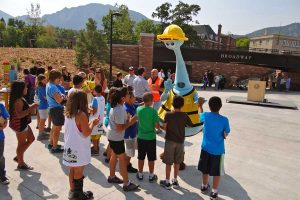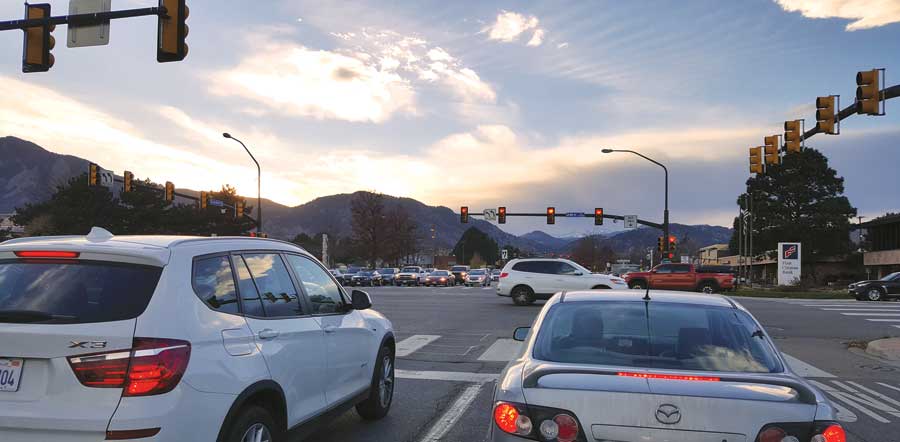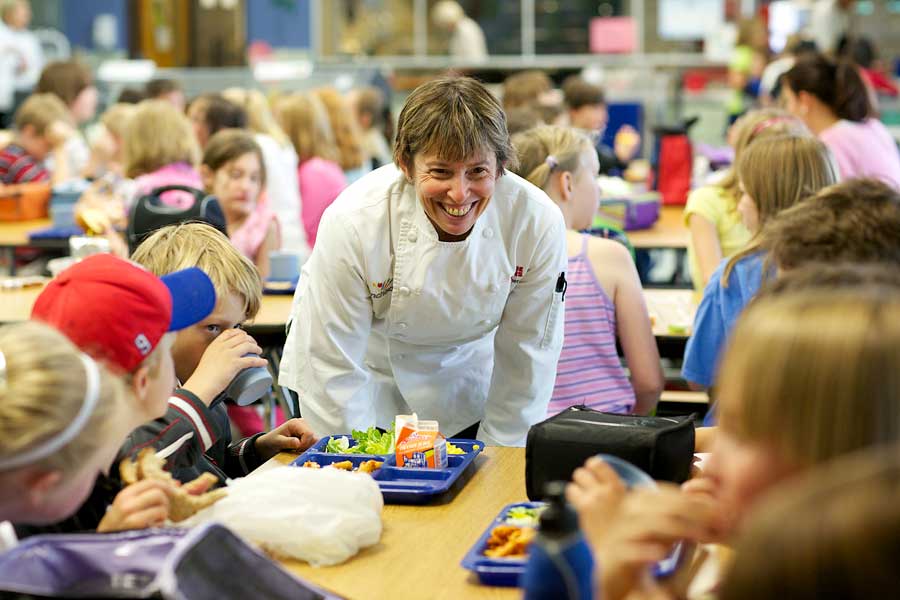Getting There from Here: Exploring options and answers to Boulder’s transportation challenges
28 Nov 2017
The city of Boulder faces numerous transit issues that are also a challenge for every Boulder County town.
Boulder Magazine asked Michael Gardner-Sweeney, director of the city’s Public Works Transportation Division, and Kathleen Bracke, GO Boulder manager for the Transportation Division, to discuss some of the questions, concerns and solutions that confront transportation planning. Battling increasing congestion, encouraging alternative modes to car travel, and finding the money to pay for it all are just a few of the topics discussed. We found them both to be enthusiastically engaged in developing answers to our local travel troubles. Regardless of the personal experience we all may have in getting around our local towns, these professionals are trying to help. Tom Brock interviewed Michael Gardner-Sweeney and Kathleen Bracke on Oct. 26, 2017, in the city’s offices at Broadway and Arapahoe Avenue.Boulder Magazine: I know the Boulder Transportation Department is tasked with many areas of concern. Most of my questions will be traffic-related. There is a fair amount of citizen consternation about traffic congestion, which drove some of the debate in the recent election. How do you perceive this congestion, and what are some solutions? Michael Gardner-Sweeney: I think it’s probably worth starting in the beginning and looking at the overall picture. We use our Transportation Master Plan as the blueprint for what we’re trying to work on. We then prepare a Report on Progress every few years. We continue to use this as a way to check in and adjust our course of action, and also figure out what to focus on. Our five current areas are Complete Streets, Regional Travel, Transportation Demand Management, Funding, and Integration with other sustainability initiatives, so connecting our transportation systems with our land use. We think that those are the five areas that we needed to focus on to be able to generate a successful future where people get to move around and minimize those impacts. We really use the Report on Progress as our way of asking, “Are those still the right things to focus on? How are we doing?” We’re just about to launch a new update in 2018 and 2019. BMag: You prepare a new master plan once every five years? MGS: Plus or minus. Our next report will either affirm those five focus areas, or we might add one or two. Funding seems to be an even more critical aspect of being able to create the future that we want. We have no idea what the federal government’s funding plan is; I don’t think they do either. The state has gone many years without addressing their long-term funding needs. RTD is basically saying that they can’t pay for the stuff that they’re just trying to implement. I think we have a lot of financial headwinds. Another new area that might be a critical one is the whole technology piece, autonomous vehicles and electric vehicles.
Our future is that the road system is largely built out. So our ability to add lanes and substantially change the curve for how many cars we can fit is pretty much done.



EcoPasses, 28th & Canyon, Planning, Google and more
BMag: I’d like to ask about some specific areas of interest to our readers. Is your department in favor of EcoPasses for all residents? KB: The communitywide EcoPass is one of the statements in the transportation master plan, and that is something that we’ve been working on for a number of years. Again, not alone, but with Boulder County and with a larger regional approach. RTD is currently hosting a working group to review various pass options. From a community-access standpoint, our goal is to create as easy access to transit as possible. EcoPass models are successful and a really easy way to access transit. BMag: But given RTD’s financial problems, they’ll need money to support that. KB: And that’s what’s being looked at through this working group. MGS: Honestly, I think one of the things that the committee is trying to sort out is, will it actually be more money or less? KB: Right. Because you could make the case [that it would cost] more. RTD gets paid up front once a year, regardless of how much the people use the service. BMag: When a new project or development is proposed, does anybody ask the transportation department a question like “What happens when we build hundreds of new hotel rooms within a one-block radius?” KB: Yup. Each development that comes in does a transportation-impact analysis that looks at how that particular land use changes or relates to the system, today and into the future, from an all-mode perspective. That is part of the development-review process for each project that comes in. BMag: What would such a process look like for 28th and Canyon, where three new hotels seem likely to make through streets and turn lanes much more congested? KB: One example that comes to me is from one of the hotels. Part of their improvements included enhancing the transit connections and the transit stop in front of the hotel. That’s an example of something that goes together—they’re not providing the transit service, but they’re providing a better interface between their guests and their employees and the transit service that’s on 28th or on Canyon. BMag: But your goal is no net new vehicles, so don’t developers have to commit to that? KB: One of the other things that new development does is create what’s called a transportation-demand management program. That’s part of how they mitigate their trip impact on the system, whether it’s an employment site or residential site, but one of the techniques they can use could be infrastructure improvement—sidewalks or transit or whatever it might be, and then the other is providing EcoPasses to their employees; that’s another way all of these things work together. We look at adding B-Cycle stations, for example. There’s a whole menu of things that could be done. BMag: Google will have 1,500 employees here in the next few years, doubling what they have now. How do you address an impact like that? MGS: I do think that there’s an aspect to the culture that relates to how they’ll access the facility and what kind of stewards they are of the environment. As Google came in, they actually joined the Boulder Junction district, and every one of their employees will have access to an EcoPass. KB: And bike-share membership, car-share membership, everything that comes in that package. MGS: As stewards, they really are trying to do all the right things to try and minimize both their footprint on the world and their transportation impacts. Also, as that area hopefully matures in a way that is more mixed use instead of kind of a monoculture development pattern, I think a lot of those trips can be walking.Riding Into the Future
BMag: Let’s talk about driverless cars. They’re coming to Boulder? MGS: Around 2024. [Stanford transportation futurist] Tony Seba’s vision is that it’ll all be economy-driven. It won’t be a governmental intervention or regulatory. The batteries will get better and cheaper, photovoltaic will get better and cheaper. Electric cars, especially in the shared-ownership model, will be so inexpensive, your current car will be worthless. It’ll be more cost effective for you and me to actually dial up one of those than to own a car. It’ll be really interesting to see if both the adoption rate and [Seba’s] prophecy around 2024 are accurate. BMag: Is your department looking at how that will work in the streets in Boulder? KB: We held a community meeting about advanced mobility on Oct. 18. It was taped, and [is now] available on the website and Channel 8, and on the city website. The meeting was looking at how does the Boulder community want to respond to what’s coming? BMag: They’re already trying it in New York City, right? KB: Yeah, they have self-driving Ubers and Lyfts in Pittsburgh already, right? So it’s already there. The question is how fast does it come here? And what our community event was about—how do we get ready for that? It’s not just about the fact that there’s new, shiny technology, but how does that new, shiny technology advance the goals that the Boulder community has? Because, at the end of the day, that’s what we’re trying to get to. It’s not just some new way to travel, but how do we create economic sustainability, environmental sustainability or climate commitment? BMag: Will there be light rail running up Canyon from 28th Street to downtown? KB: The quick [answer] is, the most successful way to do transit is to look at what the transit market is, and size the transit technology for that market. In our case, that’s high-quality, high-speed, high-frequency, rubber-tired transit. Because we want to be cost-effective, and what we implement and operate should be market based. We looked at providing the best-quality transit to serve the market, and for us that’s rubber-tired. BMag: Does that mean no gondola from the Hill to Downtown? KB [laughing]: Never say never, I guess. BMag: Two more questions. Some say the streets here are intentionally in terrible shape to deter people from driving their cars. True or false? KB: That’s definitely not true. MGS: Our No. 1 priority is safety, and so we’re not intentionally trying to make the streets unsafe. Our No. 2 priority is maintaining our investment, so the reality is we want to keep those streets in high quality. If we have resource issues, we need to figure those out. Can we get better at our jobs? Absolutely, and that’s what we’re working on every day. Another interesting wrinkle, just for context, is that a lot of the main roads in the city are state highways, and so the maintenance of the state highways is actually the responsibility of CDOT [Colorado Department of Transportation]. The condition of a street like Arapahoe or Foothills Parkway, or 28th Street or Broadway, is actually the responsibility of somebody else. We work really hard to get them to come in and keep [our streets] in good shape. We struggle, because the reality is they have a million-dollar-a-year shortfall in maintenance statewide. That’s how big their hole is. BMag: My last question to both of you is, You have decided to have careers in transportation— MGS: —so, how crazy are you?? BMag: Well, or how optimistic are you? When I was a kid we envisioned hovercrafts and transit tubes and flying airboats. In 2017, we’re not moving around much differently than we did in the 1950s. MGS: Right, and my version as a kid was that we were all going to be in these little pods, and we’d all be on these tracks, and then my pod would join with your pod because we’re heading the same way, and then Kathleen’s pod would come in and be added, and then we’d whoosh—head off … KB: … like The Jetsons. MGS: And when it was Kathleen’s turn, her pod would detach. The whole technology thing has been a really interesting struggle in that a lot of those types of ideas didn’t come to fruition. So, am I disappointed? I still think that it’s a really cool opportunity, and I approach things very analytically and conceptually, so I think it’s just a great nut to try and crack. To me it doesn’t matter so much that we’re not the Jetsons. BMag: I think The Jetsons spoiled all of us. KB: It’s a great question. By my nature, I’m very, very optimistic, and I feel like that’s just what’s helped me be appreciative of the industry and the work that we get to do every day, and so I love it. In Boulder we’re light-years ahead of many other communities, and we don’t always remind ourselves of that. It’s very apparent when we go out and spend time with professionals from other communities statewide, nationally and internationally, and it really makes you think about how great things are progressing. Yes, we have challenges, no doubt about it. But it’s the community here that helps keep pushing us to do better and better, and that, I think, is amazing. It keeps me inspired, that there is always a way to move forward. I’m very focused on the social component of moving people. So yes, I grew up with The Jetsons and all of that is cool, but for me, when it comes down to social fabric in a community, how we travel is a really important part of that. I worry that we do all end up in those isolated pods, and that takes away the social dynamic of our community. I guess that’s why I go back to that center point of how we stay connected as people moving in a community and creating those places where people come together. Whether they’re walking or biking or taking the bus or driving, it’s because we’re trying to connect people with other people and the places they want to go. The more we can do that in a way that celebrates people coming together, the better. BMag: That’s a great vision. Thank you both for your time and insight into our transportation future.Michael Gardner-Sweeney has been the director for the city of Boulder’s Public Works Transportation Division since March 2016. He oversees all aspects of the city’s transportation system, including planning and operations, maintenance, GO Boulder, and the airport. He has worked with the Transportation Division for the past 26 years, serving in a variety of roles, including principal transportation engineer, transportation operations and planning manager. Before joining the city, he worked for the City of Loveland, as well as at RTD and TransPlan Associates, Inc. Gardner-Sweeney holds a bachelor of science degree in structural engineering from the University of Colorado.
Kathleen Bracke is the GO Boulder Manager for the Transportation Division. GO Boulder’s programs include multimodal transportation master planning, corridor planning, and programs and projects that support walking, biking and transit options for the Boulder community. Prior to working for the city of Boulder, she was the Transportation Planning and Special Projects Director for the city of Fort Collins for more than 17 years. She has also worked for the Transportation Department for the City of Anaheim in Southern California. She has undergraduate and master’s degrees in Urban Planning from the University of California Los Angeles.












